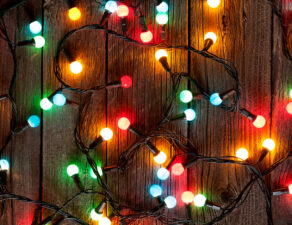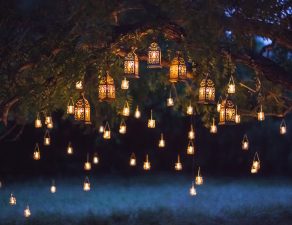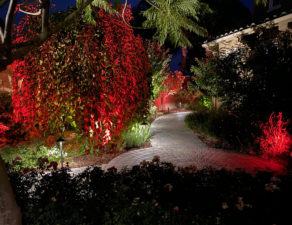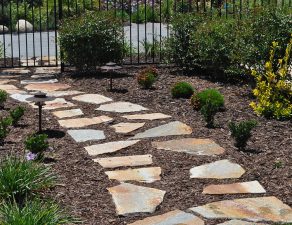
What if we told you a single project can add beauty to your landscape plus increase safety around your home? Low voltage lighting, when designed and installed thoughtfully, can accomplish both of these goals much more easily than you might believe.
First, let’s review some of the basic types of lighting available. In most cases you would use an assortment of these lights, depending upon the features and areas of your landscape that you wish to illuminate.
Waterproof pond lights illuminate water features such as ponds, waterfalls, and fountains.
Offset path lights illuminate walkways.
Wash lights offer a bit more light, to illuminate pathways and surrounding plants.
Tree-mounted spotlights simulate moonlight from above.
Flood lights illuminate trees, buildings, or other large features.
Uplighting versus downlighting. This decision is all about the direction of the lighting. You can mount a light below a feature and direct the light upward (uplighting), or install the light above a feature to illuminate the feature below (downlighting).
Consider the aesthetics of the element you’re highlighting. A Japanese maple, for example, benefits from an uplight which highlights the branch structure and delicate leaves. Uplighting other features such as columns or fountains adds drama.
On the other hand, downlighting is better for some features. The beauty of a hosta lies in its textured, variegated leaves, which are best viewed from above. Downlighting can also offer the most practical solution when a major pathway or seating area needs maximum illumination.
Why LED? Many landscape lighting professionals have switched to LED lighting, for a few important reasons. The bulbs last longer, and lower the cost of your lighting system because they use far less electricity. They also emit much less heat than halogen bulbs, which lowers your risk of a fire in the event that dry leaves or other flammable materials come into contact with lights.
Recent trends. Technology provides upgrades to landscape lighting according to how you need the system to perform. Upgrades are available to make your system more “green”, and “smart” systems allow you to control them remotely. Some landscape lighting systems even include a feature that repels mosquitoes. If you’re wondering whether a landscape lighting system can address your particular needs, the answer is probably “yes”! Give us a call to learn more, and we can help you design a system that suits your preferences.




